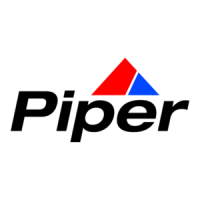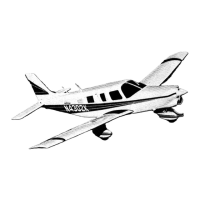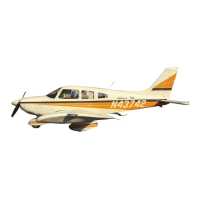SECTION 3
EMERGENCY PROCEDURES
3.1 GENERAL
The recommended procedures for coping with various types of
emergencies and critical situations are provided by this section. All of required
(FAA regulations) emergency procedures and those necessary for operation of
the airplane as determined by the operating and design features of the airplane
are presented.
Emergency procedures associated with those optional systems and
equipment which require handbook supplements are provided in Section 9
(Supplements).
The first portion of this section consists of an abbreviated emergency
checklist which supplies an action sequence for critical situations with little
emphasis on the operation of systems.
The remainder of the section is devoted to amplified emergency
procedures containing additional information to provide the pilot with a more
complete understanding of the procedures.
These procedures are suggested as a course of action for coping with the
particular condition described, but are not a substitute for sound judgment and
common sense. Pilots should familiarize themselves with the procedures given
in this section and be prepared to take appropriate action should an emergency
arise.
Most basic emergency procedures, such as power off landings, are a
normal part of pilot training. Although these emergencies are discussed here,
this information is not intended to replace such training, but only to provide a
source of reference and review, and to provide information on procedures
which are not the same for all aircraft. It is suggested that the pilot review
standard emergency procedures periodically to remain proficient in them.
PIPER AIRCRAFT CORPORATION SECTION 3
PA-38-112, TOMAHAWK EMERGENCY PROCEDURES
ISSUED: JANUARY 20, 1978 REPORT: 2126
REVISED: APRIL 28, 1989 3-1
SECTION 3
EMERGENCY PROCEDURES
3.1 GENERAL
The recommended procedures for coping with various types of
emergencies and critical situations are provided by this section. All of required
(FAA regulations) emergency procedures and those necessary for operation of
the airplane as determined by the operating and design features of the airplane
are presented.
Emergency procedures associated with those optional systems and
equipment which require handbook supplements are provided in Section 9
(Supplements).
The first portion of this section consists of an abbreviated emergency
checklist which supplies an action sequence for critical situations with little
emphasis on the operation of systems.
The remainder of the section is devoted to amplified emergency
procedures containing additional information to provide the pilot with a more
complete understanding of the procedures.
These procedures are suggested as a course of action for coping with the
particular condition described, but are not a substitute for sound judgment and
common sense. Pilots should familiarize themselves with the procedures given
in this section and be prepared to take appropriate action should an emergency
arise.
Most basic emergency procedures, such as power off landings, are a
normal part of pilot training. Although these emergencies are discussed here,
this information is not intended to replace such training, but only to provide a
source of reference and review, and to provide information on procedures
which are not the same for all aircraft. It is suggested that the pilot review
standard emergency procedures periodically to remain proficient in them.
PIPER AIRCRAFT CORPORATION SECTION 3
PA-38-112, TOMAHAWK EMERGENCY PROCEDURES
ISSUED: JANUARY 20, 1978 REPORT: 2126
REVISED: APRIL 28, 1989 3-1
